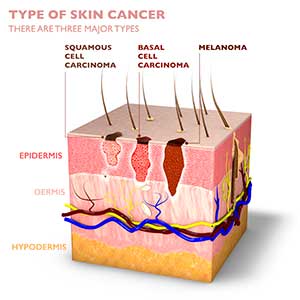Basal Cell Carcinoma Stages

The most common type of skin cancer, basal cell carcinoma (BCC) arises in the small, round cells in the outermost layer of skin (epidermis). BCC often develops in areas of the body that are frequently exposed to the sun, such as the face, ears, neck, shoulders and arms.
The first sign of basal cell carcinoma might be a painless, pearly or flesh-colored skin bump or a flat, scaly, reddish patch of skin. While the cancer tends to grow slowly and rarely spreads, early detection and treatment can lead to the best possible outcome and quality of life. Treatment may include topical medications, cryotherapy, surgery or possibly radiation therapy.
How are basal cell carcinoma stages determined?
Unlike most cancers, BCC is seldom staged. The main reason is that the extent of cancer spread is the primary consideration in most traditional cancer staging models, and basal cell carcinoma is highly unlikely to spread or metastasize. While cancer staging generally guides treatment, non-metastatic basal cell carcinoma can usually be successfully treated with a set combination of therapies.
That said, basal cell carcinoma may be staged if:
- The thickness of the lesion exceeds 2 millimeters
- Cancer cells have invaded deeper skin layers
In these instances, BCC may be staged using the American Joint Committee on Cancer (AJCC) TNM system, which evaluates the size of the tumor (T), the involvement of nearby lymph nodes (N) and the presence of metastasis (M). The stages range from 0 to 4, with higher numbers indicating more aggressive cancer.
Stage 0 basal cell carcinoma
At stage 0, cancer cells are present only in the epidermis and have not invaded deeper tissues, such as the dermis, hypodermis or nearby lymph nodes. Also known as carcinoma in situ, early-stage BCC is highly treatable and the prognosis is generally excellent. Treatment may involve topical medications, cryotherapy or a minor surgical procedure to remove the cancerous cells.
Stage 1 basal cell carcinoma
At stage 1, the BCC skin lesion is 2 centimeters or smaller in size, and the cancer has not spread to nearby lymph nodes or distant tissues. Usually, the tumor can be addressed with surgical excision, Mohs micrographic surgery or other localized treatments, with a high likelihood of successful removal and minimal risk of recurrence.
Stage 2 basal cell carcinoma
At stage 2, the BCC skin lesion measures between 2 and 4 centimeters, but the cancer has not spread to nearby lymph nodes or distant tissues. However, the tumor may have high-risk features, such as deeper invasion into the skin or an aggressive histological subtype. Treatment typically involves surgical excision of the lesion along with a wide margin of surrounding healthy tissue to help ensure complete removal. Other options may include Mohs micrographic surgery (in conjunction with USF Health) or radiation therapy, particularly if the tumor is in a difficult-to-treat location.

Ranked a Top Cancer Hospital in Nation
Moffitt is ranked 11th in the nation and is the top-ranked cancer hospital in Florida and the Southeast in Newsweek’s “America’s Best Cancer Hospitals."
Stage 3 basal cell carcinoma
At stage 3, the BCC skin lesion is larger than 4 centimeters, has grown into nearby structures, such as bones or nerves, or has spread to one nearby lymph node but has not metastasized to distant sites. This more advanced and aggressive stage of skin cancer generally requires a more comprehensive treatment approach, which may include extensive surgical excision or Mohs micrographic surgery for precise tumor removal. Additionally, radiation therapy may be considered to help prevent further cancer spread while minimizing any damage to the surrounding tissues.
Stage 4 basal cell carcinoma
At stage 4, the BCC skin lesion has spread to distant lymph nodes, bones or other tissues. The tumor may also be very large or deeply invasive, affecting nearby structures such as the skull, spine or major blood vessels. Treatment for late-stage basal cell carcinoma typically involves extensive surgery to remove the primary and metastatic tumors and other affected tissues. Surgery is usually followed by radiation therapy to help control cancer spread and manage the symptoms. Achieving a complete cure can be challenging at this stage.

What is metastatic basal cell carcinoma?
Also known as stage 4 BCC, metastatic basal cell carcinoma is a rare but severe type of skin cancer. At this late stage, cancer cells have spread beyond the original tumor site to distant parts of the body, such as lymph nodes, bones, lungs or other organs.
Benefit from world-class care at Moffitt Cancer Center
The skilled oncologists in Moffitt’s highly regarded Cutaneous Oncology Program focus exclusively on treating skin cancer, developing an individualized treatment plan for each patient in collaboration with dermatologists, plastic surgeons and other specialists. We offer the latest treatment options for basal cell carcinoma, including promising new options currently available only through our robust portfolio of clinical trials.
If you would like additional information about basal cell carcinoma stages, you can request an appointment with a specialist in our Cutaneous Oncology Program by calling 1-888-663-3488 or submitting a new patient registration form online. We do not require referrals.
Diagnosis
